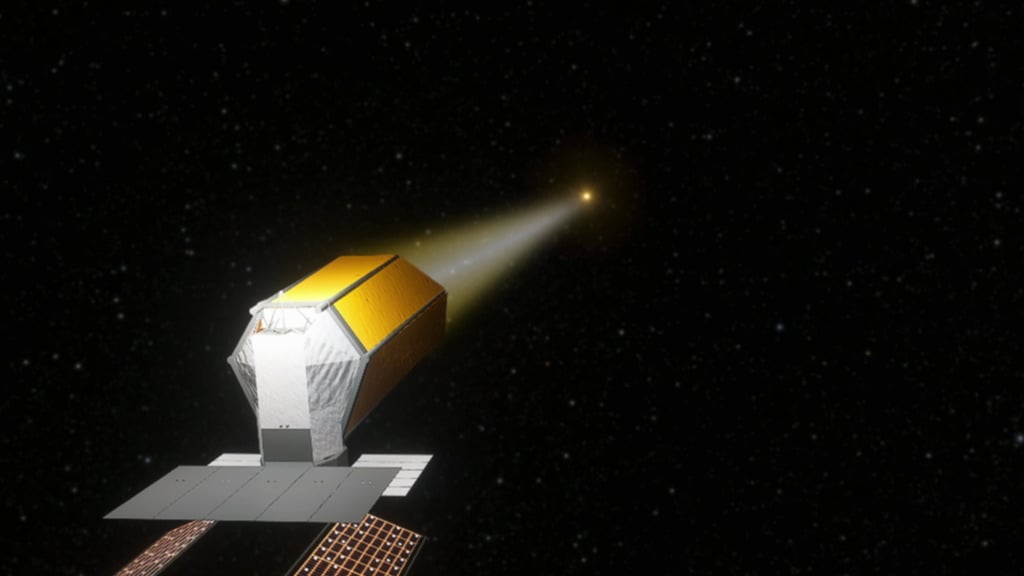Science
New Instrument Proposal Enhances Habitable Worlds Observatory’s Mission

The proposed addition of a second instrument to the Habitable Worlds Observatory (HWO) could significantly enhance its ability to identify Earth-sized exoplanets. Current plans focus on using a powerful coronagraph to search for biosignatures in the atmospheres of at least 25 Earth-like planets. However, according to a recent study by Fabien Malbet from the University of Grenoble Alpes, incorporating an astrometric tracking instrument could allow HWO to detect such planets around hundreds of nearby stars.
The study suggests that this astrometric instrument could achieve precision of 0.5 micro-arcseconds (μas), vastly improving upon the capabilities of existing missions like Gaia, which operates at a precision of about 20-30 μas. This enhancement would dramatically increase the number of candidate planets available for atmospheric analysis, as currently, only 12% of sun-like stars within 65 light years are known to host planets, and all identified are gas giants.
Detecting rocky exoplanets near our solar system has proven challenging. The signals from these planets often become lost amid background noise generated by missions like Gaia. The proposed astrometric instrument would be 400-600 times more precise than Gaia, making it feasible to locate smaller planets, including potential exo-Earths, which could then be further investigated using the HWO’s coronagraph.
Achieving such high precision relies on two primary factors: an advanced calibrator and a substantial number of images. The astrometric sensors, which measure a star’s “wobble” due to orbiting planets, have been utilized for decades. A more precise instrument can detect smaller wobbles, corresponding to lower planet masses, such as those of Earth compared to larger planets like Jupiter.
Despite their advantages, astrometric methods are susceptible to errors from various sources, including detector imperfections and mirror misalignments. To mitigate these risks, Dr. Malbet and his co-authors propose the use of a “Detector Calibration Unit” (DCU). This device would generate light and dark bands across the CMOS sensor, allowing for the isolation and correction of errors before they compound. This calibration would ensure the precise positioning of every pixel in the instrument’s field of view, crucial for obtaining reliable data from multiple images.
Dr. Malbet’s team estimates that HWO would need to take over 100 individual measurements of a target planet throughout its operational life of 3-4 years. This extensive data collection is necessary to ensure that any residual random errors do not significantly affect the final results. By combining numerous images, the impact of these random errors can be minimized.
In addition to its primary mission of identifying habitable worlds, the astrometric instrument could also contribute to research in astrophysics, particularly in testing theories related to Cold Dark Matter (CDM). The CDM theory posits that dark matter forms “cusps” at the centers of galaxies, but existing data suggests these regions may be better described as “cores.” The new instrument could detect subtle wobbles caused by dark matter density variations, providing insights into the nature of dark matter and its distribution in galaxies.
The concept of enhancing HWO with this astrometric capability is not new; Dr. Malbet was previously involved in the proposal for the Theia mission, which aimed to achieve similar objectives as a standalone initiative. Integrating this technology into the HWO seems logical, as it aligns with the observatory’s main goal of discovering habitable planets.
While development for HWO is not expected to commence until the 2030s, with a launch anticipated in the 2040s, there is ample opportunity to implement this enhancement. The successful integration of the astrometric instrument could significantly advance humanity’s search for life beyond Earth and deepen our understanding of the universe.
-

 Science2 weeks ago
Science2 weeks agoIROS 2025 to Showcase Cutting-Edge Robotics Innovations in China
-

 Politics2 weeks ago
Politics2 weeks agoJudge Considers Dismissal of Chelsea Housing Case Citing AI Flaws
-

 World2 weeks ago
World2 weeks agoBravo Company Veterans Honored with Bronze Medals After 56 Years
-

 Lifestyle2 weeks ago
Lifestyle2 weeks agoStone Island’s Logo Worn by Extremists Sparks Brand Dilemma
-

 Health2 weeks ago
Health2 weeks agoStartup Liberate Bio Secures $31 Million for Next-Gen Therapies
-

 Top Stories2 weeks ago
Top Stories2 weeks agoIndonesia Suspends 27,000 Bank Accounts in Online Gambling Crackdown
-

 Health2 weeks ago
Health2 weeks agoTop Hyaluronic Acid Serums for Radiant Skin in 2025
-

 Sports2 weeks ago
Sports2 weeks agoMel Kiper Jr. Reveals Top 25 Prospects for 2026 NFL Draft
-

 World2 weeks ago
World2 weeks agoHoneywell Predicts Record Demand for Business Jets Over Next Decade
-

 Sports2 weeks ago
Sports2 weeks agoYamamoto’s Mastery Leads Dodgers to 5-1 Victory in NLCS Game 2
-

 Politics2 weeks ago
Politics2 weeks agoNew Jersey Voters Urged to Register Ahead of November Election
-

 Lifestyle2 weeks ago
Lifestyle2 weeks agoMary Morgan Jackson Crowned Little Miss National Peanut Festival 2025









